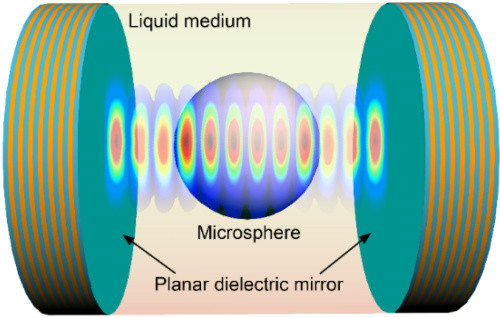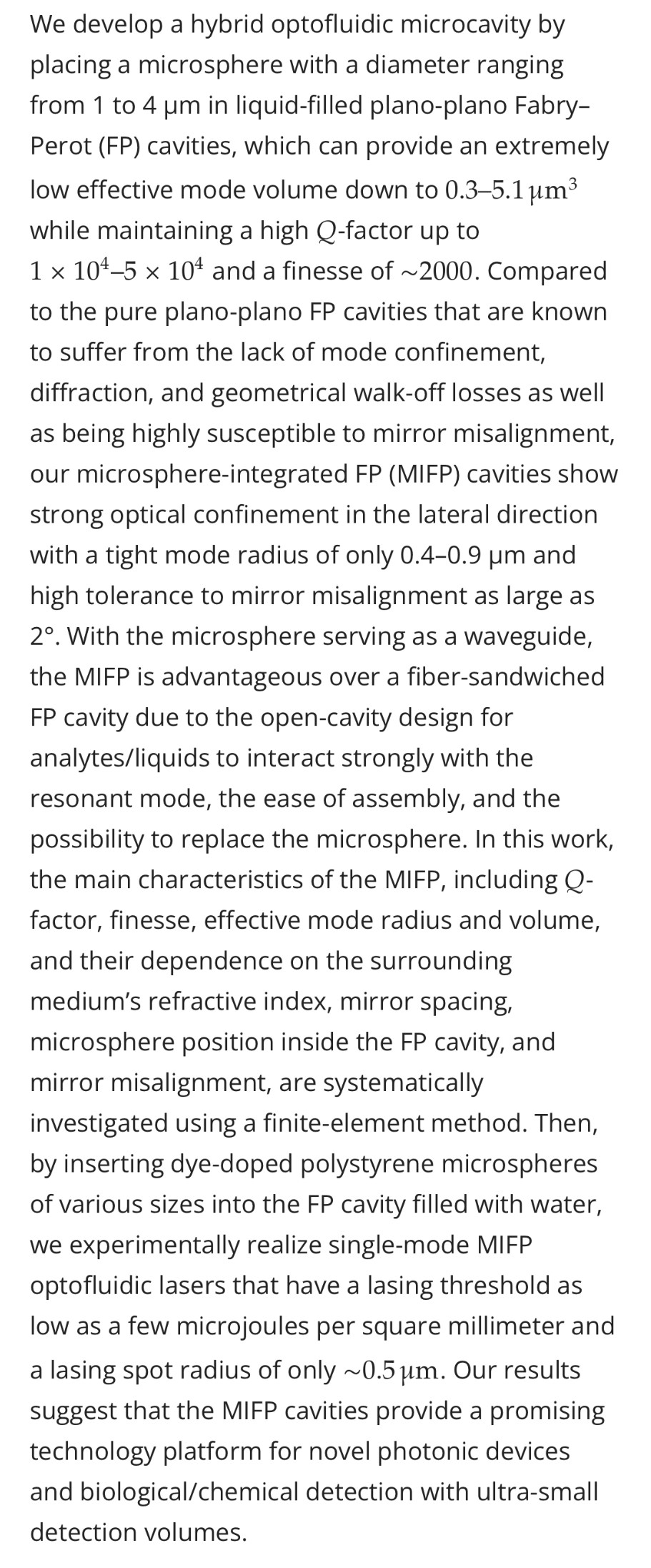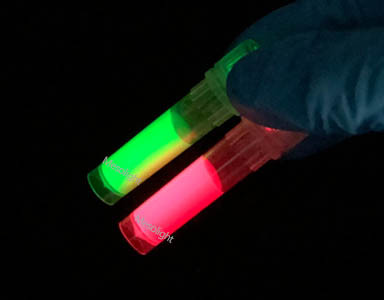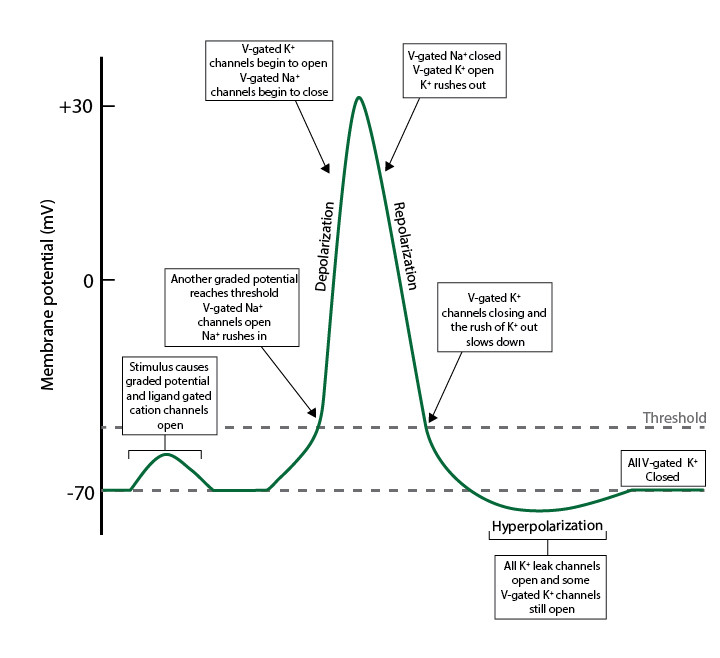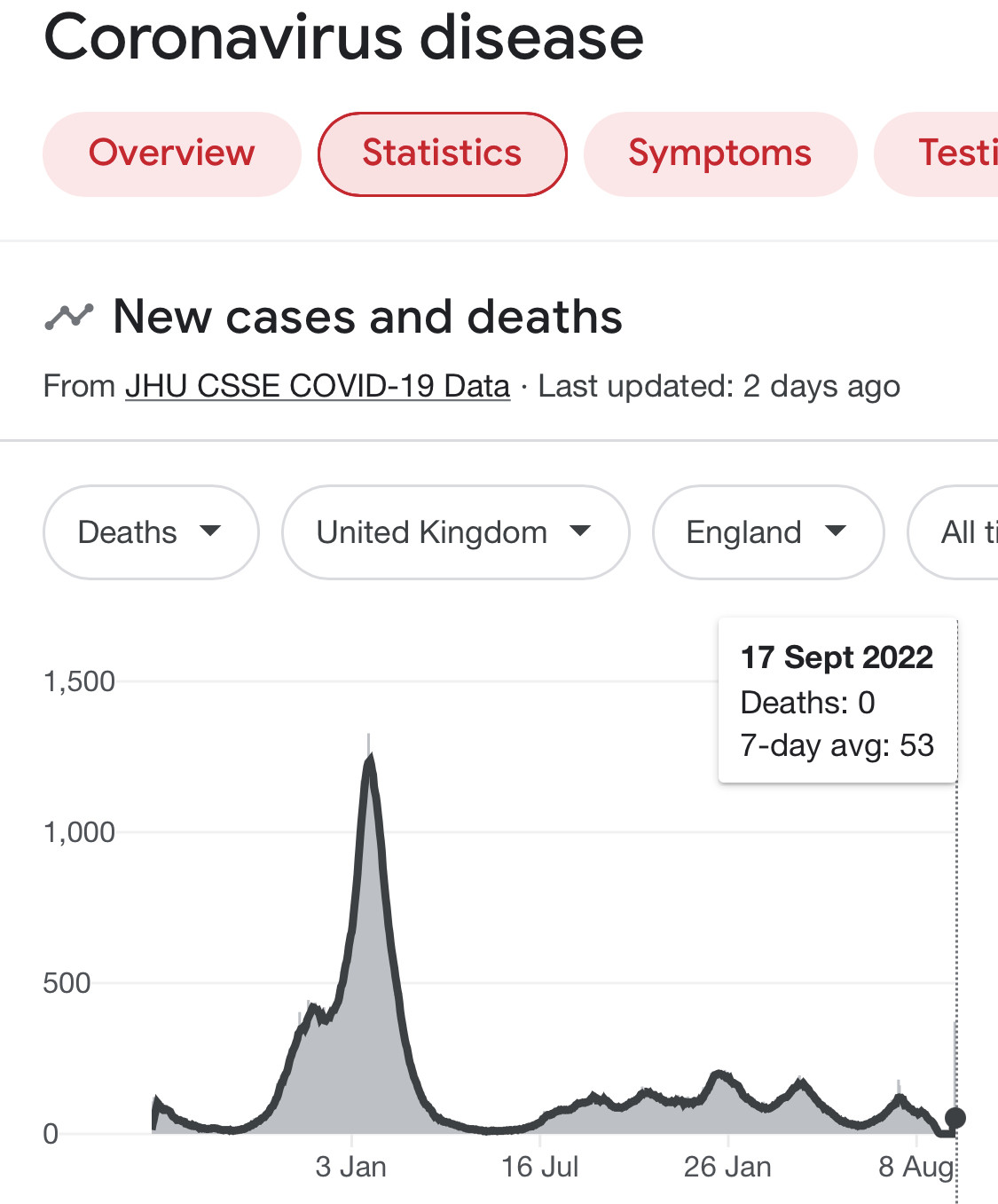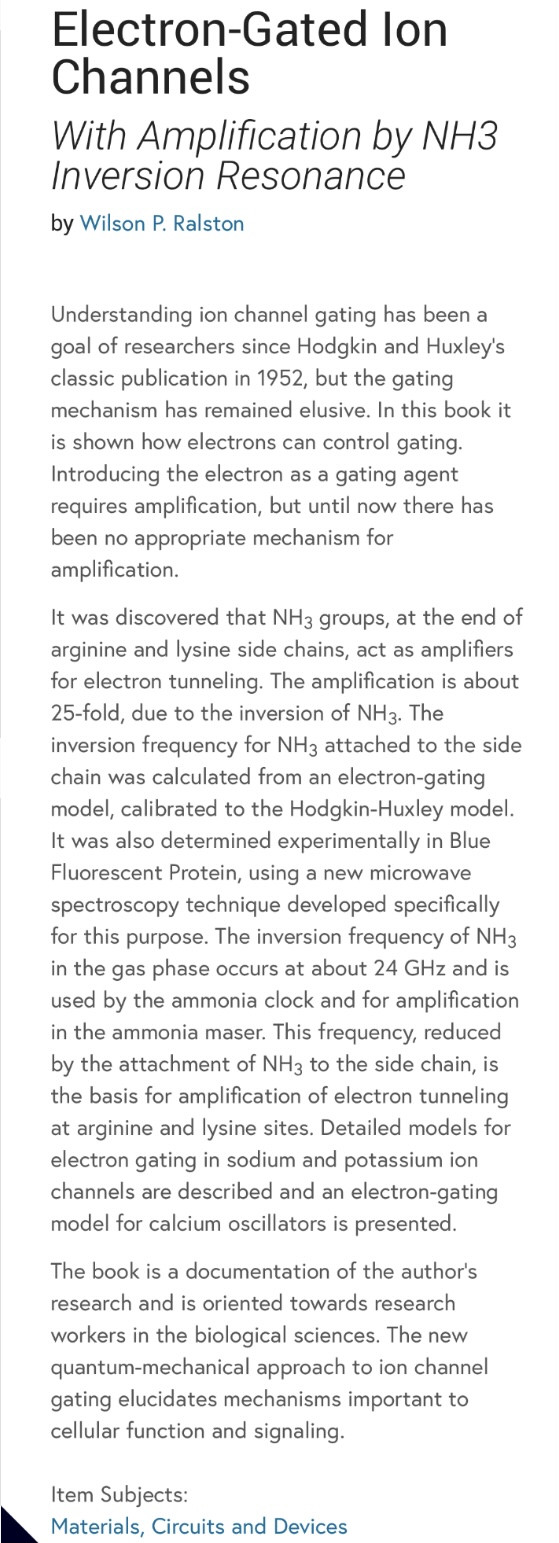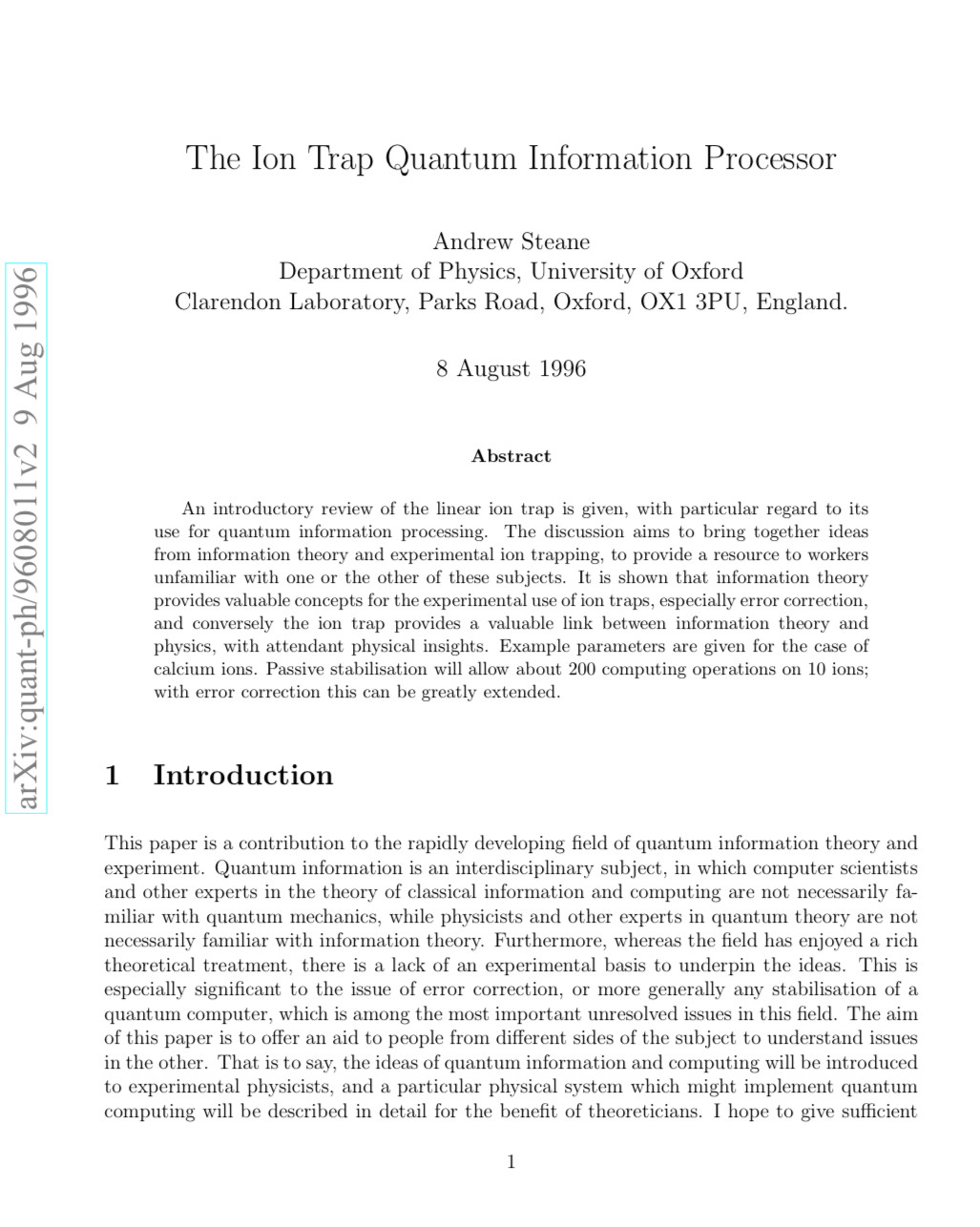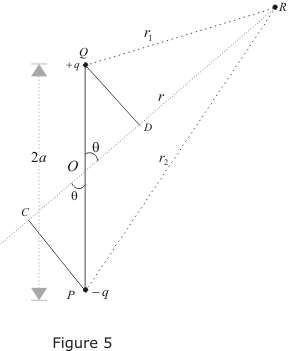So basicslly vaccines function as ion traps for quntum computing.
The End.
what does that mean. computing humans that took the vax?
Excuse the spelling my screen is cracked.
Trapped atomic ions are standards for quantum information processing, serving as quantum memories, hosts of quantum gates in quantum computers and simulators, and nodes of quantum communication networks. Quantum bits based on trapped ions enjoy a rare combination of attributes: They have exquisite coherence properties, they can be prepared and measured with nearly 100% efficiency, and they are readily entangled with each other through the Coulomb interaction or remote photonic interconnects. The outstanding challenge is the scaling of trapped ions to hundreds or thousands of qubits and beyond, at which scale quantum processors can outperform their classical counterparts in certain applications. We review the latest progress and prospects in that effort, with the promise of advanced architectures and new technologies, such as microfabricated ion traps and integrated photonics.
Trapped ions represent the leading system for quantum information processing, but to scale it further might require using quantum optical interconnects. To this end, we have developed a planar microfabricated ion trap array integrated with a high-finesse optical cavity for strong collective ion-photon coupling:
Cetina et. al., "One-dimensional array of ion chains coupled to an optical cavity", New Journal of Physics, 15(5), 53001 (2013) [arXiv:1302.2904]
One challenge of combinging high-finesse optical cavities with trapped ions is that the desired transition wavelengths are in the UV, where high-finesse mirror coatings suffer from creeping loss, especially under vacuum. We performed a detailed study of this effect and provided a set of recipes to mitigate it:
Gangloff et. al., "Preventing and reversing vacuum-induced optical losses in high-finesse tantalum (V) oxide mirror coatings", Optics Express, 23(14), 18014 (2015) [arXiv:1505.03381]
Optically adressing ions and cavities in the UV faces another challenge: the large linewidth of UV diode lasers (cheap and scalable compared to alternative laser sources). We showed that the linewidth of UV diode lasers can be narrowed by orders of magnitued to 2kHz by means of optical feedback from an extended fiber cavity:
Samutpraphoot et. al., “Passive intrinsic-linewidth narrowing of ultraviolet extended-cavity diode laser by weak optical feedback”, Optics Express 10, 11592 (2014). [arXiv:1402.6379]
An optical cavity, resonating cavity or optical resonator is an arrangement of mirrors that forms a standing wave cavity resonator for light waves. Optical cavities are a major component of lasers, surrounding the gain medium and providing feedback of the laser light.
Quantum Dots Microspheres
Description
1. Our quantum dot microspheres have a uniform shell and have stronger rigidity
2. Stable performance, no fluorescence attenuation under the conditions of various conventional medicine, food, drug testing samples. Room temperature can be stored for 2 years.
3. High fluorescence intensity, more than 85% quantum yield, strong anti-bleaching ability.
4. High sensitivity, helping the development of Femto-level detection reagents.
5. The particle size is uniform and consistent between batches.
6. It can be directly replaced and compatible with the time resolution platform.
Cationic liposomes are commonly used for transfection of plasmids into mammalian cells, while microspheres have been traditionally used for selective delivery of anticancer agents into tumor vasculature. We have developed a novel vector, comprised of cationic liposomes electrostatically bound to ion-exchange microspheres (termed 'microplex') for targeted gene therapy of solid tumors.
An ion-exchange resin or ion-exchange polymer is a resin or polymer that acts as a medium for ion exchange. It is an insoluble matrix (or support structure) normally in the form of small (0.25–1.43 mm radius) microbeads, usually white or yellowish, fabricated from an organic polymer substrate. The beads are typically porous, providing a large surface area on and inside them where the trapping of ions occurs along with the accompanying release of other ions, and thus the process is called ion exchange. There are multiple types of ion-exchange resin. Most commercial resins are made of polystyrene sulfonate.
In cell biology, ion trapping is the build-up of a higher concentration of a chemical across a cell membrane due to the pKa value of the chemical and difference of pH across the cell membrane.
Liberation is the first step in the process by which medication enters the body and liberates the active ingredient that has been administered. The pharmaceutical drug must separate from the vehicle or the excipient that it was mixed with during manufacture. Some authors split the process of liberation into three steps: disintegration, disaggregation and dissolution. A limiting factor in the adsorption of pharmaceutical drugs is the degree to which they are ionized, as cell membranes are relatively impermeable to ionized molecules.
Ion channels are located within the membrane of all excitable cells, and of many intracellular organelles. They are often described as narrow, water-filled tunnels that allow only ions of a certain size and/or charge to pass through. This characteristic is called selective permeability.
Ion channels are pore-forming membrane proteins that allow ions to pass through the channel pore. Their functions include establishing a resting membrane potential,[1] shaping action potentials and other electrical signals by gating the flow of ions across the cell membrane, controlling the flow of ions across secretory and epithelial cells, and regulating cell volume. Ion channels are present in the membranes of all cells.[2][3] Ion channels are one of the two classes of ionophoric proteins, the other being ion transporters.[4]
Trapped atomic ions are one of the most promising platforms for realising a useful quantum computer. They exhibit all properties necessary for building such a system and have very few fundamental limitations to the achievable gate fidelity. The single- and two-qubit gate fidelities demonstrated in small-scale systems, combined with the ions' long coherence times, exceed the capabilities of any other proposed architecture. However, to build a useful quantum simulator that outperforms current classical machines (and therefore achieve ‘quantum advantage’) the system size needs to be scaled up to at least a few tens of qubits without compromising the precision of the operations.
Ions also interface naturally with optical photons, enabling quantum networking. We work on photonically-networked ion traps, the development of microfabricated chip trap technology, and high-fidelity quantum logic operations.
An action potential occurs when the membrane potential of a specific cell location rapidly rises and falls. This depolarization then causes adjacent locations to similarly depolarize. Action potentials occur in several types of animal cells, called excitable cells, which include neurons, muscle cells, and in some plant cells. Certain endocrine cells such as pancreatic beta cells, and certain cells of the anterior pituitary gland are also excitable cells.
Dipole moments occur when there is a separation of charge. They can occur between two ions in an ionic bond or between atoms in a covalent bond; dipole moments arise from differences in electronegativity. The larger the difference in electronegativity, the larger the dipole moment. The distance between the charge separation is also a deciding factor in the size of the dipole moment. The dipole moment is a measure of the polarity of the molecule.
Electronegativity, symbolized as χ, is the tendency for an atom of a given chemical element to attract shared electrons (or electron density) when forming a chemical bond.[1] An atom's electronegativity is affected by both its atomic number and the distance at which its valence electrons reside from the charged nucleus. The higher the associated electronegativity, the more an atom or a substituent group attracts electrons. Electronegativity serves as a simple way to quantitatively estimate the bond energy, and the sign and magnitude of a bond's chemical polarity, which characterizes a bond along the continuous scale from covalent to ionic bonding. The loosely defined term electropositivity is the opposite of electronegativity: it characterizes an element's tendency to donate valence electrons.
“Electropositivity can be defined as the tendency of an atom to donate electrons and form positively charged cations.”
An antioxidant is a molecule stable enough to donate an electron
Oxidation is the loss of electrons during a reaction by a molecule, atom or ion. Oxidation occurs when the oxidation state of a molecule, atom or ion is increased. The opposite process is called reduction, which occurs when there is a gain of electrons or the oxidation state of an atom, molecule, or ion decreases.
"The new quantum-mechanical approach to ion channel gating"
Quantum mechanics is a fundamental theory in physics that provides a description of the physical properties of nature at the scale of atoms and subatomic particles. It is the foundation of all quantum physics including quantum chemistry, quantum field theory, quantum technology, and quantum information science.
Ion channels are transport proteins present in the lipid bilayers of biological membranes. They are involved in many physiological processes, such as the generation of nerve impulses, hormonal secretion, and heartbeat. Conformational changes in the ion channel-forming protein allow the opening or closing of pores to control the ionic flux through the cell membranes. The opening and closing of the ion channel have been classically treated as a random kinetic process, known as a Markov process. Here the time the channel remains in a given state is assumed to be independent of the condition it had in the previous state.
More recently, however, several studies have shown that this process is not random but a deterministic one, where both the open and closed dwell-times and the ionic current flowing through the channel are history-dependent. This property is called long memory or long-range correlation. However, there is still much controversy regarding how this memory originates, which region of the channel is responsible for this property, and which models could best reproduce the memory effect. In this article, we provide a review of what is, where it is, its possible origin, and the mathematical methods used to analyze the long-term memory present in the kinetic process of ion channels.
Ion channels are ubiquitous membrane proteins in mammalian cells. Their critical physiological roles include control of the electrical potential across the membrane, facilitation of neuromuscular and neuronal transmission, signal transduction, and regulation of secretion and contractility
Electric Potential of a Dipole
Potential due to an electric dipole
We already know that electric dipole is an arrangement which consists of two equal and opposite charges +q and -q separated by a small distance 2a.
Electric dipole moment is represented by a vector p of magnitude 2qa and this vector points in direction from -q to +q.
To find electric potential due to a dipole consider charge -q is placed at point P and charge +q is placed at point Q as shown below in the figure.

